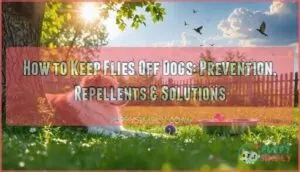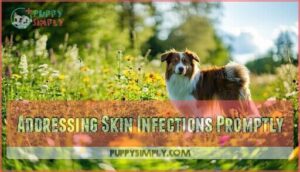This site is supported by our readers. We may earn a commission, at no cost to you, if you purchase through links.
 Your dog’s ears are bleeding—again. Those tiny red dots, the constant head-shaking, the way she won’t settle in her favorite sunny spot anymore. Flies don’t just annoy dogs; they inflict genuine harm, spreading disease and creating painful wounds that attract even more pests.
Your dog’s ears are bleeding—again. Those tiny red dots, the constant head-shaking, the way she won’t settle in her favorite sunny spot anymore. Flies don’t just annoy dogs; they inflict genuine harm, spreading disease and creating painful wounds that attract even more pests.
The cycle becomes relentless without intervention. Most owners underestimate how quickly a minor fly problem escalates into infected bites, especially during warm months when stable flies and horseflies turn backyards into hunting grounds.
Fortunately, understanding what draws flies to your dog and implementing targeted prevention strategies can break this cycle within days, protecting your pet from both immediate discomfort and long-term health complications.
Table Of Contents
- Key Takeaways
- Why Are Flies Attracted to Dogs?
- What Types of Flies Bother Dogs?
- How to Prevent Flies From Biting Dogs
- Safe Fly Repellents and Home Remedies
- Creating a Fly-Free Environment for Dogs
- Frequently Asked Questions (FAQs)
- How do you keep a dog from biting flies?
- How do I get rid of flies on my Dog?
- How do I stop flies from bothering my dog?
- How to keep flies away from a dog?
- Can dogs use essential oils to repel flies?
- How to get rid of flies in a Dog’s Garden?
- How do I keep flies off my dog naturally?
- What repels flies but safe for dogs?
- Do certain dog breeds attract more flies?
- Can dietary changes reduce fly attraction?
- Conclusion
Key Takeaways
- Flies target dogs primarily due to odors from poor hygiene, open wounds, natural body oils, and underlying health conditions—eliminating these attractants through regular bathing, prompt wound care, and proper grooming breaks the infestation cycle within days.
- Specific fly species pose different threats: house flies spread disease through contaminated contact, horseflies inflict painful blood-feeding bites, and bot flies implant larvae under the skin requiring surgical removal, making identification critical for effective treatment.
- Safe prevention combines natural repellents (diluted neem oil, apple cider vinegar, petroleum jelly barrier creams) with environmental controls like daily waste removal, eliminating standing water, and providing shaded, clean resting areas away from breeding grounds.
- Persistent fly problems despite home remedies warrant veterinary consultation, as over 75% of chronic cases improve with customized professional treatment that addresses underlying conditions attracting flies and prescribes stronger prescription-grade repellents.
Why Are Flies Attracted to Dogs?
Flies zero in on dogs for specific reasons, and understanding these triggers helps you protect your pet.
From unpleasant odors to underlying health issues, several factors make dogs attractive targets for these persistent pests.
Let’s break down the main culprits that draw flies to your dog.
Odors From Dirty Fur and Feces
Flies zero in on your dog’s coat like a magnet when it’s matted with feces, urine, or built-up grime—turning poor hygiene into an open invitation for pests. This fecal attraction happens because house flies thrive on organic waste, and a dirty coat broadcasts those furry odors like a neon sign.
Dogs with diarrhea or incontinence face the worst risk, since smelly fur becomes a breeding ground that compromises both canine hygiene and dog health, making effective insect repellent and consistent pet care essential for animal health.
Open Wounds and Skin Conditions
Any break in your dog’s skin—whether it’s a hot spot, scrape, or oozing rash—sends out chemical signals that pull flies in from yards away, and those pests waste no time landing on vulnerable tissue. Skin infections and fly bites create a vicious cycle, since each landing irritates damaged tissue and prolongs healing.
Prompt attention to dog health stops this escalation cold.
- Open wounds attract persistent swarms that worsen inflammation
- Canine skin care delays allow bacteria to thrive under fly activity
- Itch relief becomes harder as scratching reopens healing tissue
- Insect bites on raw areas can transmit secondary infections
- Neglected wound care turns minor scrapes into chronic sores
Sweat and Body Oils
Even healthy dogs produce natural oils and moisture on their skin that work like a flashing neon sign for hungry flies, especially when heat and humidity crank up sweat production in areas with thin fur. Sebum control and skin pH balance shift throughout the day, creating zones of concentrated body odor that override even the best natural fly repellent strategies.
| Factor | Why Flies Are Drawn In |
|---|---|
| Oil glands | Secrete fatty acids that broadcast chemical signals |
| Sweat reduction | Impossible in hot weather—moisture pools attract swarms |
| Insect repellent | Washes off quickly when dogs produce excess sebum |
| Fly bites | Target oily ear tips, belly folds, and groins for insect control challenges |
Illness, Diarrhea, and Poor Grooming
When your dog battles chronic illness, struggles with loose stool, or misses regular coat care, you’re virtually rolling out the red carpet for every fly in the neighborhood. Dirty coat issues and fecal attraction combine with skin infections from grooming neglect, creating health complications that invite relentless fly bites.
Incontinent or ill dogs face the worst exposure—parasite prevention and treatment becomes urgent when poor dog health and wellness turns your pet into a fly magnet, demanding immediate attention to canine health and medicine concerns for dog health and safety.
What Types of Flies Bother Dogs?
Not all flies pose the same threat to your dog. Some are simply annoying, while others can bite, burrow, or even transmit disease. Understanding which flies you’re dealing with helps you protect your pet more effectively.
House Flies and Their Behavior
House flies might seem like harmless pests, but they’re drawn to your dog for reasons that go beyond simple annoyance—and understanding their behavior is the first step in keeping them at bay.
These insects rely on advanced Fly Vision Systems to locate food sources, making soiled fur and waste irresistible targets. House flies breed rapidly in organic matter, and their constant buzzing signals potential Fly Bites on ears and muzzles—areas where Preventing Fly Bites on Dogs becomes critical for comfort and health.
Horseflies and Blood-Seeking Activity
Unlike house flies that simply irritate, horseflies are aggressive hunters that slice through a dog’s skin to feed on blood—and their bites pack a painful punch that can leave your pet distressed and vulnerable to infection. Horsefly behavior centers on Blood Feeding during warmer months, targeting thinly-haired areas like ears and bellies.
Bite Symptoms include immediate swelling, bleeding, and intense discomfort that prompts frantic scratching. Fly Attraction peaks near water sources where horse flies breed.
Using Insect Repellents and Fly Repellents specifically designed for Preventing Fly Bites on Dogs becomes essential when these bloodthirsty pests are active.
Bot Flies and Their Larvae
Bot flies don’t just buzz around your dog—they implant living larvae under the skin, turning a simple outdoor romp into a parasitic nightmare that requires immediate veterinary intervention. Understanding the Fly Life Cycle helps you catch Larval Infections early:
- Bot Fly Removal requires surgical extraction—never attempt this yourself
- Parasite Prevention through Insect Repellents and Fly Repellents disrupts egg-laying
- Effective Pest Management combines Fly Trap Methods with veterinary Parasite Control
Risks of Fly-Borne Diseases
Flies aren’t just a nuisance—they’re vectors for serious Fly-Borne Diseases like canine parvovirus, which flies can spread up to 20 km in a single day. Disease Transmission occurs when flies land on infected feces, then transfer pathogens to your dog’s skin, wounds, or food.
Canine Infections such as myiasis (larval infestation) affect up to 45% of dogs in some regions, causing severe ulcerations and secondary bacterial complications.
Your Parasite Prevention strategy must include Fly Repellents and aggressive Pest Management for Pets to minimize these Health Risks. Regular screenings for vector borne diseases are essential to preventing the spread of diseases.
How to Prevent Flies From Biting Dogs
Prevention starts with controlling what attracts flies in the first place. The good news is that a few simple habits can make a real difference in protecting your dog from painful bites and potential infections.
Here’s what works.
Regular Bathing and Grooming
Keeping your dog’s coat clean isn’t just about appearances—it’s one of the most effective ways to cut off the scent trail that draws flies in the first place. Regular shampooing removes oils, debris, and odors that attract pests, while proper grooming tools help maintain skin health and fur maintenance year-round.
Essential dog care and grooming practices include:
- Bathe weekly or biweekly with vet-approved shampoo to eliminate attractants and support canine skin care
- Brush daily to distribute natural oils, prevent matting, and promote healthy dog coat care
- Inspect thoroughly after outdoor activities to catch early signs of irritation or contamination
Cleaning Up After Your Dog
The flies circling your yard aren’t just after your dog—they’re after what your dog leaves behind, and every pile you skip becomes an open invitation for an infestation.
Daily waste removal and proper poop disposal are non-negotiable for dog hygiene and yard sanitation. Dispose of feces immediately in sealed bags, sanitize contaminated surfaces, and maintain consistent fecal management practices to protect pet health and support effective canine care and maintenance routines.
Trimming Hair in Sensitive Areas
Long-haired breeds and dogs with thick coats around their ears, eyes, and rear end create perfect landing pads for flies. A quick trim in those areas can make all the difference. Use rounded-tip grooming clippers for clipper safety around the dog’s nose, ears, and genital regions.
Regular hair trimming in these sensitive areas improves canine hygiene and dog health and safety while supporting effective dog ear care and health. Proper grooming tips include maintaining canine skin care routines and keeping fur manageable without exposing vulnerable skin to direct bites.
Addressing Skin Infections Promptly
Once trimming is done, you’ll want to watch for any red, crusty, or oozing patches—skin infections don’t just make your dog miserable, they send out an open invitation to every fly in the neighborhood. Infected skin releases odors that attract more flies, creating a vicious cycle. Catch problems early and consult your vet for proper antibiotic use and dermatitis treatment.
Key infection control steps:
- Clean affected areas with mild soap and water daily for proper dog hygiene
- Apply veterinarian-recommended antibiotic ointments to support wound healing
- Use barrier creams or insect repellent around healing areas to prevent dog fly bites
- Monitor skin infections closely—untreated dermatitis attracts persistent fly activity
Safe Fly Repellents and Home Remedies
You have several safe options to keep flies away from your dog without resorting to harsh chemicals. Some remedies use natural ingredients you likely have at home, while others involve veterinary-approved products designed specifically for dogs.
Before trying any repellent, it’s smart to know what works and what requires professional guidance.
Essential Oil-Based Sprays and Roll-Ons
Natural fly repellents derived from essential oils offer a safer alternative to synthetic chemicals, though you’ll want to confirm your dog tolerates them before regular use. Neem and peppermint oil blends work as effective aromatic deterrents when diluted properly.
Spray formulas provide broad coverage, while roll-on applications target vulnerable areas like ears and muzzles. These natural remedies incorporate aromatherapy principles for insect repellents and pest control without harsh ingredients.
Apple Cider Vinegar and Lemon Solutions
If essential oils aren’t your first choice, you can reach for two kitchen staples that many dog owners swear by—apple cider vinegar and fresh lemon juice. Both natural remedies disrupt a fly’s sensory radar through their sharp acidity, making your dog less appealing without harsh chemicals.
Mix equal parts water and vinegar or diluted lemon juice into homemade remedies you can spray lightly onto your dog’s coat:
- Vinegar sprays create an invisible shield that flies won’t cross
- Lemon juice blends aromatic deterrence with fly prevention
- Both solutions double as coat conditioners when properly diluted
- These herbal repellents complement broader insect repellents and pest control strategies
Always avoid sensitive areas like eyes and open wounds.
Petroleum Jelly and Barrier Creams
When flies target your dog’s ears, nose, or other vulnerable spots, a physical barrier can work better than any spray. Products like Petroleum Jelly or Fly Repella Cream create a protective layer that flies can’t penetrate, giving your dog relief from fly bites while wounds heal. Apply these Barrier Creams 2-3 times daily to affected areas—Vaseline works in a pinch for the nose and ear tips.
| Product Type | Application Frequency | Best Use Areas |
|---|---|---|
| Petroleum Jelly | 2-3 times daily | Nose, ear tips |
| Fly Repella Cream | 2-3 times daily | Wounds, thin-haired spots |
| Topical Ointments | As directed | Open sores, irritated skin |
| Skin Protectants | Morning and evening | Face, belly |
| Barrier Creams | After outdoor time | Any vulnerable area |
These insect repellent barriers complement your broader fly repellent strategy.
Consulting With a Veterinarian
Professional Assessment becomes essential when home remedies fall short or fly bite problems persist. Your vet can identify the fly species targeting your dog, prescribe stronger Repellent Selection options not available over the counter, and rule out underlying conditions attracting flies.
Veterinary Guidance ensures safe Fly Bite Treatment, monitors healing progress, and adjusts protocols if needed—studies show over 75% of chronic cases improve with customized Veterinary Care rather than generic approaches alone.
Regular yard maintenance and fly prevention strategies, such as using fly repellent methods, can also help reduce the risk of fly infestations.
Creating a Fly-Free Environment for Dogs
Keeping flies away isn’t just about treating your dog—it’s about controlling the space where they spend time. Your yard, kennel, and outdoor areas can either invite flies or send them packing.
Here’s how to create an environment that keeps those pests at bay.
Yard and Waste Management
Your yard isn’t just your dog’s playground—it’s also a buffet and breeding ground for flies if you’re not staying on top of waste removal. Proper sanitation practices are your first line of defense in pest control. Pick up droppings immediately—flies can lay eggs within minutes. Keep grass trimmed, eliminate standing water, and secure compost bins tightly.
Outdoor safety for dogs depends on these fly prevention and control basics:
- Remove waste twice daily to break the breeding cycle before larvae develop
- Relocate compost management areas away from where your dog rests or plays
- Schedule regular yard cleaning sessions focusing on forgotten corners and shaded spots
- Install fly traps strategically around waste disposal zones to catch adults before they reach your pet
Using Fly Traps and Repellents
Combining physical barriers with chemical deterrents gives you a two-pronged defense that addresses flies from both angles—stopping them before they land and driving them away if they get close. Fly traps like flypaper capture adults near problem zones, while repellent sprays containing natural oils create a protective barrier on your dog’s coat. Electronic repellents and ultrasonic devices offer hands-off insect control, though results vary by species.
| Fly Control Method | Best Application |
|---|---|
| Fly Traps (sticky strips) | High-traffic outdoor areas |
| Repellent Sprays (neem, citronella) | Direct coat application |
| Insect Nets | Kennel or rest zone coverage |
| Electronic Repellents | Stationary outdoor spaces |
| Bug Repellent Creams | Ears, nose, sensitive skin |
Rotate between fly spray formulations and physical barriers to prevent resistance and maintain effective insect control and repellents throughout peak season.
Providing Shaded, Clean Resting Areas
Flies don’t just buzz around your dog—they actively seek out warm, sheltered spots to rest, feed, and lay eggs, which makes a grimy or sun-scorched lounging area an open invitation for persistent infestation.
Build Canine Sanctuaries that prioritize Dog Safety and Animal Health and Hygiene:
- Position Clean Kennels in Shaded Areas away from direct sun
- Install Fly Screens over outdoor Resting Spots
- Replace bedding weekly to eliminate odors
- Hose down concrete or dirt surfaces daily
- Keep water bowls fresh to support Pet Safety and Protection
This setup discourages flies while keeping your dog comfortable during Outdoor Activities.
Removing Breeding Grounds and Standing Water
Standing water isn’t just an eyesore—it’s a fly nursery where dozens of larvae can hatch in a matter of hours, turning your backyard into a buzzing battlefield for your dog.
Target Moisture Control through aggressive Waste Removal and Yard Sanitation to disrupt Insect Control Methods.
| Source | Action | Frequency |
|---|---|---|
| Pet bowls | Empty and refill | Twice daily |
| Gutters | Clear debris | Weekly |
| Flower pot saucers | Drain or remove | Daily |
| Compost heaps | Cover or relocate | Ongoing |
This Water Management strategy, paired with Fly Traps, aids Pest Management for Pet Owners by eliminating breeding sites for Flies and Mosquitoes before they proliferate.
Frequently Asked Questions (FAQs)
How do you keep a dog from biting flies?
Dogs snapping at flies often signal they’re bothered by persistent buzzing or bites.
Redirect this behavior with fly repellents for dogs, barrier creams, or dog fly masks that protect vulnerable areas like ears and eyes, reducing irritation and the urge to bite.
How do I get rid of flies on my Dog?
Start with dog hygiene tips—bathe regularly and clean soiled fur immediately. Use fly repellents for dogs like neem oil or barrier creams on vulnerable areas. Address skin infections promptly.
Implement fly control methods: remove waste, use traps, and create shaded resting spots away from breeding grounds.
How do I stop flies from bothering my dog?
Buzz off, pests! Combine regular grooming with outdoor fly control measures like yard sanitation and fly traps. Apply dog-safe fly repellents or barrier creams to vulnerable areas, especially ears and nose. Schedule walks during midday sun or windy conditions when flies are less active.
How to keep flies away from a dog?
Keep insects at bay through consistent canine hygiene—bathe regularly, clean wounds promptly, and use vet-approved fly and insect repellents for dogs.
Outdoor fly control includes removing waste, eliminating standing water, and applying barrier creams for fly bite treatment and protection.
Can dogs use essential oils to repel flies?
Think of essential oils as a double-edged sword—they can repel flies but harm dogs if misused.
Certain therapeutic grade essential oils like neem or peppermint work as natural fly deterrents when properly diluted, but consult your veterinarian first to confirm safe application.
How to get rid of flies in a Dog’s Garden?
Remove compost heaps and standing water to eliminate breeding grounds. Regular yard sanitation and garden cleanup create effective fly barriers for outdoor pet care.
Use outdoor repellents, fly traps, and insect screens strategically.
How do I keep flies off my dog naturally?
Try neem or peppermint essential oils diluted in water as natural fly repellents. Apple cider vinegar sprays work well too.
Regular bathing improves dog hygiene, while petroleum jelly protects vulnerable spots like ears.
What repels flies but safe for dogs?
Several natural deterrents work well: neem oil, citronella, and essential oils like peppermint.
Dog-safe fly sprays such as RepelX or petroleum jelly-based barrier creams offer protection.
Always consult your veterinarian before applying any insect repellent.
Do certain dog breeds attract more flies?
Ironically, what makes a breed beautiful can make it vulnerable. Breeds prone to skin folds or oily coats—like Bulldogs or Basset Hounds—tend to attract more black flies and deer flies due to trapped moisture and scent.
Poor canine hygiene compounds the issue, regardless of breed characteristics or genetic predisposition to certain conditions.
Can dietary changes reduce fly attraction?
While dietary changes alone won’t eliminate fly attraction, improving digestive health through nutrient balance and probiotic benefits can reduce fecal odors that draw flies.
Addressing food allergies and adding omega supplements also promotes canine wellness by supporting healthy skin—reducing infections that attract flies seeking wounds.
Conclusion
Your dog’s wound healed within three days once you finally broke the cycle—that’s the difference strategic intervention makes. Learning how to keep flies off dogs isn’t about perfect execution; it’s about creating layers of protection through consistent grooming, immediate wound care, and environmental management.
When flies lose access to the scents and conditions that draw them, your dog reclaims comfort you’d almost forgotten was possible. The sunny spot becomes peaceful again, head-shaking stops, and those bleeding ears finally heal.
- http://eepurl.com/bLfZQf
- https://pmc.ncbi.nlm.nih.gov/articles/PMC7114225/
- https://www.nature.com/articles/s41598-024-71148-1
- https://www.thevetiverse.com/en-gb/latest/the-importance-of-canine-vector-borne-disease-screening-with-the-rise-of-coinfection-rates/
- https://www.esccap.org/uploads/docs/32ir16g1_0775_ESCCAP_Guideline_GL5_20241203_1p.pdf













